If you were to tell me a few weeks ago that we’d have Godzilla in Standard, I’d first make sure you’re actually talking about Magic before proceeding to question you even further.
Ikoria: Lair of Behemoths has shaped up to be a dream set for practically everyone; an incredible crossover for kaiju fans, several sweet new Commanders, a slew of alternate art cards for collectors, and some powerful new spells to shake up Standard and beyond. For us more cost-conscious mages, there are even many new cards at lower rarities and price points that are sure to be excellent performers in eternal formats.
I’m going to be taking a look through the best budget cards in Ikoria: Lair of Behemoths, and examine their potential in Standard, Modern, Pioneer, and Pauper. I’ll be focusing heavily on the commons and uncommons in the set, but I’ll also include rares or mythics if they’re proving to be either cheap staples or good budget replacements for more expensive cards.
Let’s start with the cards that may be less format-altering, but could be role-players in specific strategies or have more narrow application. The further down we go, the greater the impact I feel the cards will make.
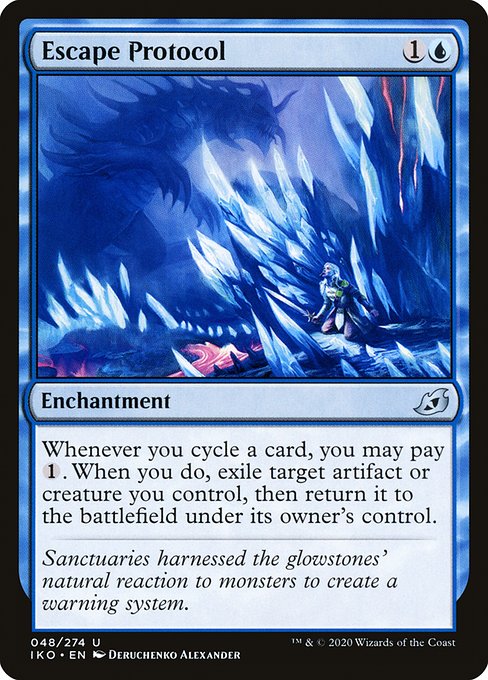
This seemingly innocuous little enchantment has a lot of potential in the right shell. Escape Protocol could be used in conjunction with creatures in three main ways: to protect high-value targets from removal, to make combat a nightmare by flickering tapped creatures to ambush attackers, or to abuse enter the battlefield triggers. A particularly disgusting one I’m excited to try and repeat is the ETB effect on Frilled Mystic.
It may also fit well in an Astral Slide deck, which has been trying to be a thing for quite some time, though that’s likely to be more of a pet deck than a true contender.
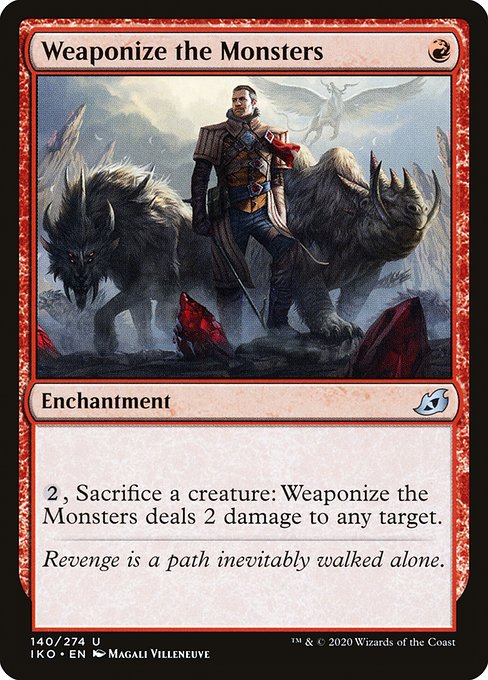
A somewhat fixed version of Goblin Bombardment, Weaponize the Monsters could be used in Standard or Pioneer as a backup sacrifice outlet to cards like Witch’s Oven. This has some downsides in comparison, like requiring mana to activate and not providing a means to loop with Cauldron Familiar. Still, a couple of copies could make their way into BRx Sacrifice decks. Having this on the battlefield turns the combat phase into a headache for opponents, and combos wonderfully with Mayhem Devil.
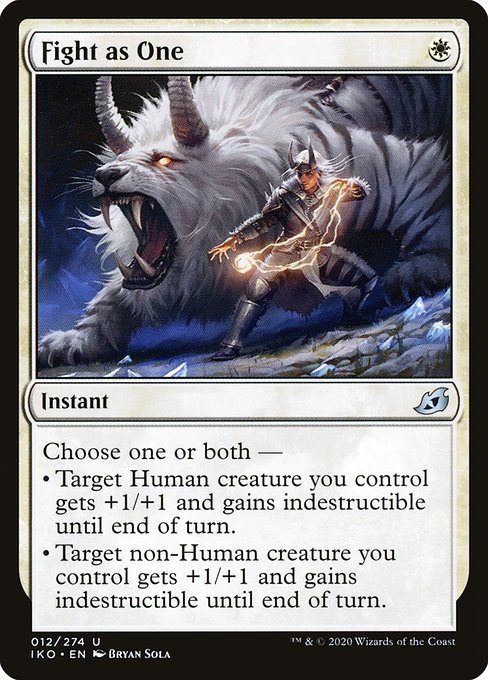
Boros Feather is one of the lesser-played decks in Pioneer, but with the right pilot it can be a force to be reckoned with. In its current state it has a highly tuned main deck with very few flex slots, but I believe Fight as One has the potential to shake things up.
Boros Feather, by Ogol, Pioneer League
| Creatures (20) 4 Favored Hoplite 4 Monastery Swiftspear 4 Dreadhorde Arcanist 4 Tenth District Legionnaire 4 Feather, the Redeemed Spells (20) 4 Defiant Strike 4 Gods Willing 4 Reckless Rage 4 Titan's Strength 4 Boros Charm | Lands (20) 3 Battlefield Forge 3 Clifftop Retreat 4 Inspiring Vantage 3 Mountain 3 Plains 4 Sacred Foundry Sideboard (15) 3 Wild Slash 2 Declaration in Stone 2 Fry 2 Rest in Peace 2 Tomik, Distinguished Advokist 2 Gideon Blackblade 2 Wear // Tear |
Of the twenty creatures in this Feather deck, twelve of them are Human and eight are not. Not only is this spell a great piece of protection in more removal-heavy metagames, but it can also protect most (if not all) of your board from wraths like Supreme Verdict. Fight as One pairs particularly well with Dreadhorde Arcanist too—as the second most important creature for accruing value (after Feather herself), it’s important to make sure that it has free reign to do its thing. Pumping their power allows them to flash back Boros Charm, and the indestructible means it’s always going to survive combat.
Another benefit that Fight as One has in this deck is the ability to mitigate the (admittedly slight) downside of Reckless Rage. As Reckless Rage deals damage to your creature as well as your opponent’s, they become susceptible to damage-based removal like Wild Slash. While the deck already has Gods Willing and Boros Charm to help protect against this, it’s a weak use of the charm, and Gods Willing doesn’t provide any stat boosts by itself. Plus, any additional redundancy in a deck that relies so heavily on consistency is surely welcome.
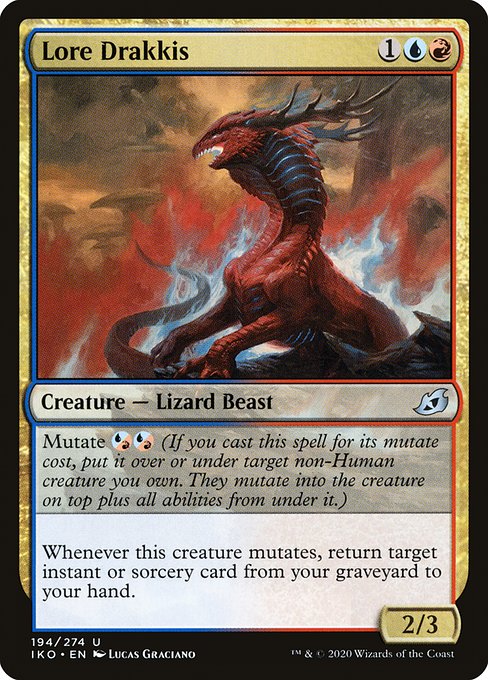
Okay, I’ll admit it: I skipped over Lore Drakkis when I first read it, thinking that this wouldn’t be good enough to see play anywhere. After trying it out in Standard and Pioneer, I am happy to say that I was incorrect in my initial evaluation.
The most important thing that I’ve learned about the Mutate mechanic is this: if you can protect your mutated creature, it will snowball out of control. The decks most capable of doing this are some of my favourite: aggressive Tempo decks. I see this being a powerful roleplayer, alongside cards like Sea-Dasher Octopus.
It’s capable of not only providing a different form of card advantage to our tentacled friend, but also upgrading your smaller threats. Putting this on an adapted Pteramander to make them into a 6/7 flier and get back Dive Down feels too good. On top of that, Mutate is cumulative: a successful Mutate with Lore Drakkis means you get back a key spell; if you Mutate again, for example using Dirge Bat, you’ll not only kill a creature but return another card to your hand.
In Standard, this can be included in Dimir Flash and only cast for its Mutate cost, removing the need to weaken the mana base for the Red in the spell’s cost. It’s for this reason that I see this as a great new tool for Mono Blue Tempo in Pioneer, which has been flying under the radar for some time now. These decks would likely only want one or two of the Lizard Beast in the seventy five, but the impact they could have on them might be enough to bump them up a tier or two.
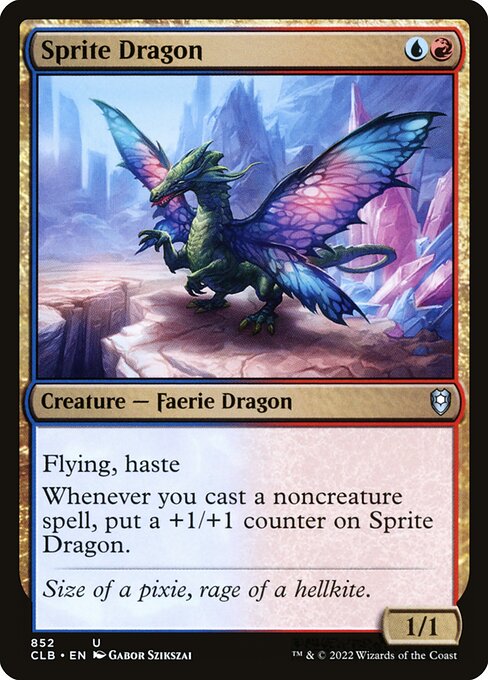
This little faerie is one of the lowest-costed dragons in Magic’s history, and it’s poised to make an impact in multiple formats. Sprite Dragon has an almost supercharged version of the Prowess mechanic, with its ability to retain the power and toughness boost it gains from noncreature spells. This gives you more scope to fire off your spells whenever you like and still gain incremental benefit from them.
Izzet Phoenix has been a couple of spells short of being a real contender in Standard since rotation, but I think that Sprite Dragon is an excellent reason to revisit the deck. As a key role-player in the spellslinger archetype, the Sprite serves as an early and evasive aggressor that gains incidental value from most actions you’ll take. While you’re busy trying to execute your slower, more resilient Arclight Phoenix game plan, this little faerie dragon can either win the game for you, or soften your opponent up just enough to push through with the birds.
Pioneer has seen some Izzet Prowess lists make the top tables on rare occasions, and I believe that having Sprite Dragon as another tool in its belt can only stand to benefit the deck. It may also revitalise Izzet Phoenix in this format; there are currently two different creatures that serve as its early payoffs, and they are indicative of the style of play the pilot intends to adopt. A Phoenix deck with Young Pyromancer aims to grind out by way of clogging up the ground, allowing the birds to attack freely. Thing in the Ice goes bigger, using its bounce effect to set opponents back and close the game quickly once the corner has been turned. The problem in the current metagame is that they are both too slow—by the time you’re set up, Lotus Breach decks have, well, breached; Dimir Inverter has inverted; and Mono White Devotion has possibly gone infinite. These decks need to be pressured constantly, and this is where I believe Sprite Dragon may truly shine.
In Modern, this would be a fantastic addition to any Izzet Spells/Prowess deck, likely replacing any copies of Stormchaser Mage. I’d be lying if I said I didn’t want Delver decks to make a comeback, and while this alone may not be enough, I think it’s a great start.
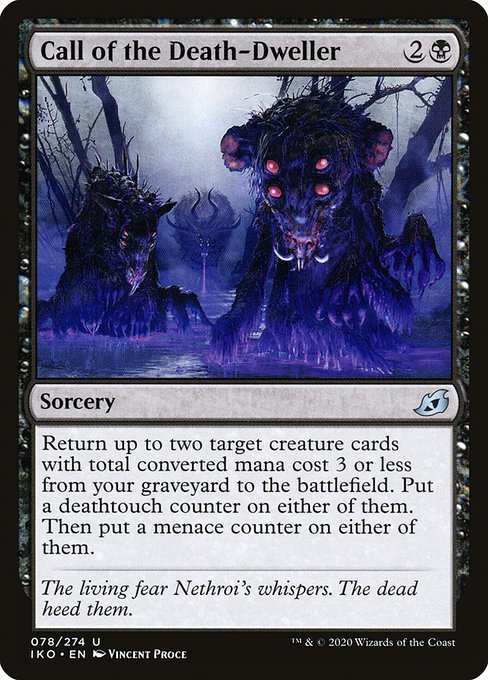
Reanimation spells are a peculiar lot—they’re much-loved by many, and have a history of being either too powerful or near unplayable. Difficult to balance, their quality is not only judged by their efficiency, but also the power of the potential reanimation targets. It’s because of this that Reanimate sees play in Legacy, but Blood for Bones is considered too weak for Modern. Unearth is an example of a perfectly balanced reanimation spell: it’s cheap, versatile, yet restricted by converted mana cost.
Call of the Death-Dweller is, in my opinion, the newest powerful and impactful reanimation spell. It has the potential to be incorporated into both fair and unfair strategies for years to come. This almost certainly goes into Rakdos Sacrifice in Standard: being able to bring back Mayhem Devil while giving it deathtouch certainly pushes the boundaries of what defines a “fair” strategy. It’s something I look forward to.
Kethis Combo has been on the fringes of Pioneer since the format’s inception, and the potential to bring back more than one combo piece makes me think that this level of reinforcement might be enough to push the deck up out of obscurity and into the currently settled metagame. In addition to this, the idea of bringing back Goblin Chainwhirler with deathtouch for a mini-Plague Wind effect is an exciting one to consider. While there is no current deck in Pioneer that this will slot directly into, I believe it’s powerful enough to warrant brewing and exploration.
Call of the Death-Dweller’s applications in Modern will be wide and varied. I can see this in multiple variations of Death’s Shadow decks, with Jund likely being the best due to increased threat density. Mardu Shadow has the benefit of being able to recur Tidehollow Sculler alongside a Shadow, and Grixis builds can instead return a downed Snapcaster Mage for extra value. Devoted Druid Combo decks can return up to two of their combo pieces at a time—likely replacing any copies of Postmortem Lunge. Rakdos 8-Ball decks can recur anything from Flamekin Harbinger to Kroxa, Titan of Death’s Hunger to Seasoned Pyromancer. The possibilities of this card are still largely unexplored, and I’m sure we haven’t found its best application yet, but I’m excited to start looking for it.
Despite companions building up a Bad Reputation, this set is chock-full of killer budget cards that are also poised to make a monstrous mark on Magic. I could wax lyrical about them for hours, but there’s no substitute to starting up Arena or Magic Online, and slinging spells at mutated monsters. There are a wealth of treasures hidden in Ikoria: Lair of Behemoths, and not all of them have a gold rarity symbol!
Join me next week when I’ll break down the removal options in Ikoria: Lair of Behemoths, and the impact it will have on multiple formats!
Scott is an Irish content creator and head of the budget division of the Izzet League. His primary focuses are Pioneer, Modern, and Pauper, and he can be found storming off on Twitch and Youtube.

